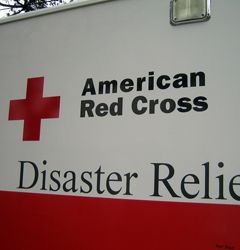A cargo plane comes in for a landing in what looks like a war zone–toppled buildings, livestock wandering the streets, people sleeping under tarps fashioned into makeshift tents.
It’s January 2010 in Haiti, and an earthquake has just devastated this nation, killing 200,000 people and injuring thousands more. Volunteers rush up to the plane to offload critical food, medicine and other supplies.
A Red Cross humanitarian mission? Not exactly. At its time of need, Haiti is full of volunteers from around the globe—and this plane, from the United Arab Emirates, operates under the flag not of the Red Cross, but the Red Crescent.
You probably already know something about the history of the Red Cross in the United States—that it was founded after the Civil War by a nurse, Clara Barton. But the very first Red Cross was founded in Switzerland, by a young man named Henry Dunant.
In 1859, during the Crimean War, Dunant witnessed a horrific sight—more than 40,000 soldiers lying dead or wounded on an Italian battlefield, with no one to give the injured any medical care. Dunant sprang into action and mobilized the local citizenry, who fed and took care of the injured. The experience left Dunant convinced that an organized effort was needed to provide relief to war victims.
Four years later, Dunant and four colleagues in Geneva officially organized what would later become the International Committee of the Red Cross. The symbol of the movement became a red cross on a white background…an inversion of the design and colors of the Swiss flag.
Clara Barton, traveling in Europe after the Civil War, decided to bring the movement home to the U.S. She campaigned tirelessly for her idea, and in 1881 the American Red Cross was founded in Washington, D.C.
The Red Cross has always done disaster relief and humanitarian work around the globe, but the Movement’s organizers did realize that the cross had religious significance not always shared by people of other faiths. In 1929, the Red Crescent symbol was introduced, and more than 30 Islamic nations now operate chapters under this insignia.
There’s also the Red Crystal, a diamond-shaped emblem used by Israel’s disaster relief and emergency medical services.
Today, the International Federation of Red Cross and Red Crescent Societies has branches in more than 150 countries worldwide—and counts on the help of more than 13 million volunteers. Those volunteers stay busy, too!
This year, the American Red Cross has already provided relief to victims of emergencies such as February’s massive winter storm in the U.S. and the recent civil unrest in Northern Africa. It is still a huge part of life in Haiti as well. More than one year after that earthquake, they have put in place a $7 million.
“This organization touches the lives of people all over the world,” says Joan, a Red Cross volunteer. “I like knowing that I can help make a difference in the world.”
For more information about the Red Cross and Red Crescent, visit http://www.ifrc.org.
Photo by Elaine Vigneault/Flickr
Download your FREE ebook, Inspirational Quotes About Life, Love, Faith and Hope






